Resistant varieties and additional fungicides can assist growers in protecting their basil crops from downy mildew infection.
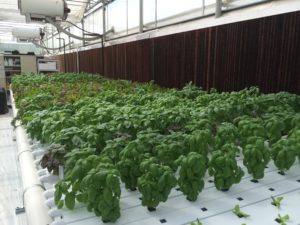
Whether basil is grown in controlled environment structures or outdoors, downy mildew can be a destructive disease of this crop.
“For organic basil crops, downy mildew can be quite devastating and usually results in total crop loss that happens in just a few days,” said Alan DeYoung, director of ag research and development at Van Drunen Farms in Momence, Ill. “Once an organic crop is infected, the disease moves right across the field defoliating the plants. It is so prolific. For conventionally-grown crops, if we do a good job with our spray program we can protect the crop. As long as we spray on time we can manage the disease.”
Van Drunen Farms along with its sister company Golden State Herbs in California grow about 700 acres of basil outdoors.
“The only place other than Illinois where environmental conditions are more conducive to downy mildew development is in Florida,” DeYoung said. “Illinois has humid and cool temperatures that the downy mildew pathogen (Peronospora belbahrii) likes. In Illinois the disease usually occurs in July. The environmental conditions at that time are ideal for downy mildew.
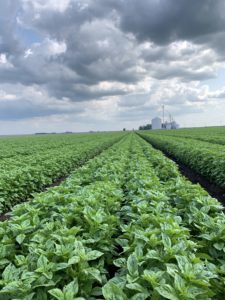
“In California we grow in the southern desert area. Environmental conditions that favor downy mildew don’t usually start there until mid-September and then the disease can occur. One of the worst outbreaks I’ve seen of basil downy mildew occurred in southern California, but it occurred much later in the year.”
Introduction of basil downy mildew
In warmer climates the basil downy mildew pathogen can overwinter. Michigan State University plant pathologist Mary Hausbeck said in her state and other northern states, the pathogen cannot survive outdoors during the winter and must be introduced into a field. This typically happens through wind-dispersed spores in southern plantings and also through the planting of downy mildew contaminated seed.
“Contaminated seed was probably how the pathogen was first introduced into Florida,” Hausbeck said. “The pathogen has become established in Florida and other southern states and can overwinter there. Growers in these states expect to deal with the disease all the time.” The basil crops produced by Van Drunen Farms and Golden State Herbs are direct seeded. “We normally don’t use transplants,” DeYoung said. “We have to wait until May to plant basil in Illinois. The season is long enough in Illinois so that we can begin harvesting in July and finish harvesting during the first week of October.
“The season in California is about two months longer. This allows us to plant a month earlier and harvest a month later.”
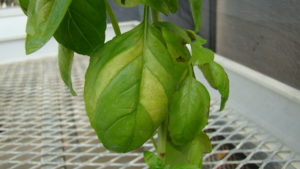
North Carolina State University plant pathologist Lina Quesada-Ocampo said there is not a lot of basil production in her state, but there are a number of controlled environment growers who produce a substantial number of basil transplants.
“I work with both controlled environment growers and field growers,” Quesada-Ocampo said. “There aren’t as many field growers of basil and there is not as large acreage as in other states like in Florida. North Carolina has more medium- to small-size field basil growers. We do have a few large controlled environment growers who sell transplants to retailers and field growers.
“In the case of transplant production, sometimes the seed can be infected, which can immediately become a problem. Sometimes air currents can spread the pathogen’s spores from field crops into greenhouses. Weather is a major factor in spreading the disease. It can also depend on the time of year. In states like North Carolina where there is high humidity, if we happen to experience a drier year the disease may not be as bad.”
Cornell University plant pathologist Margaret McGrath is monitoring where basil downy mildew has occurred in the United States.
“The disease is an issue in a lot of states,” McGrath said. “There are a few states which are in drier parts of the U.S. where the disease has not been reported yet. Some of the states where the disease has not been reported are not as populated as East Coast states. On the East Coast, in addition to field production, there are a lot of people who garden. The number one herb for many home gardeners is basil. Since basil is grown throughout the eastern U.S., this can magnify the downy mildew problem.
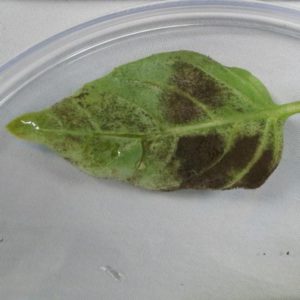
“The disease is a problem in both controlled environment and field production. With greenhouse production there is the advantage of being able to control the environment better. But as the weather becomes more humid the disease is harder to control even in a greenhouse.”
Developing disease-resistant varieties
Another way that Van Drunen Farms is trying to manage basil downy mildew is through the planting of disease-resistant varieties that were bred at Rutgers University.
“Our company has licensed four resistant sweet basil varieties from Rutgers University,” DeYoung said. “Because we needed these varieties we decided to get involved with seed production. Van Drunen Farms has a division called VDF Specialty Seeds [https://www.vdfspecialtyseeds.com]. We are producing the seed in southern California. Basil loves the heat and it does very well in the desert which is the ideal place to produce the seed. “As a company we did not feel it would be right to keep these varieties to ourselves, so we started this division of specialty seeds to make the resistant varieties available worldwide through distributors. This venture has been very successful and we have received rave reviews about how much longer the resistant varieties last compared to other susceptible varieties.” Even though these varieties are highly resistant to downy mildew, DeYoung said they are not immune to the disease.
“With some conventionally-grown crops supplemental fungicide applications still need to be made,” he said. “If we miss a fungicide application we have the backup genetic resistance that helps us continue to grow the crop until we are able to get back into the field to apply fungicides. That has made a big difference.
“For organically grown crops, the resistant varieties are the only thing we have that we can use to fight downy mildew. The first year we planted the resistant varieties in Illinois, instead of downy mildew occurring in July, we were able to continue harvesting basil into October.”
Van Drunen Farms is working with IR-4 Project to develop an organic program that would include the disease-resistant varieties.
“There are new varieties we are testing that can combine the genetic resistance with approved organic fungicides,” DeYoung said. “Using resistant varieties with organic fungicides will give organic growers a good program to manage downy mildew. We are also distributing new resistant varieties to IR-4 researchers to trial around the country.”
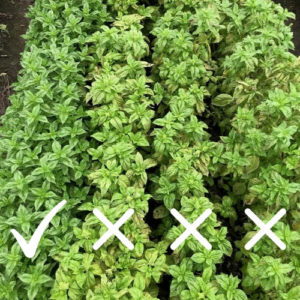
Expanding fungicide choices
While the development of disease-resistant varieties has been critical to the management of basil downy mildew, DeYoung said it is just as important to continue to expand the number of fungicides that can be applied to the crop.
“We work closely with Dr. Mohammad Babadoost, a plant pathologist at the University of Illinois,” DeYoung said. “We do crop safety efficacy work on our own trial plots for various crops and diseases, including basil downy mildew. Dr. Babadoost designs the testing protocols for the efficacy trials. We publish that information and submit it to IR-4. The testing provides efficacy data for Illinois. We did this for the fungicide fluopicolide which was labeled through IR-4 for use on basil.”
McGrath said there are several reasons why the registration of fluopicolide for management of basil downy mildew is so important.
“Fluopicolide is a new active ingredient that can be used in rotation with fungicides already registered for resistance management,” McGrath said. “Having more fungicides available in different chemical groups means a stronger resistance management program. This also facilitates the growers’ ability to comply with label-use restrictions of all targeted fungicides. Having multiple fungicides is also important in areas with long production seasons such as Hawaii.”
Hausbeck said growers now have better fungicide options to stop basil downy mildew.
“Growers should rotate chemicals with different modes of action,” Hausbeck said. “Since seed contamination is a concern, growers should apply a fungicide as soon as the seed is sown. During propagation the growing medium is going to be moistened which could prompt the pathogen to develop. The timing of this fungicide treatment is critical.
“I have been working with the IR-4 Project to make sure any new chemistries that have shown good control of downy mildew on other crops be entered into the IR-4 system so they can also be considered for basil. Unfortunately for organic basil production, OMRI-listed products for this disease may not provide the needed protection when environmental conditions are cool and wet.”
DeYoung said basil field crops are typically scouted two to three times a week.
“Downy mildew can almost be predicted on the calendar,” he said. “Day length, leaf wetness and temperature are all factors in the development of the disease. There is some relief if the temperature goes above 95ºF. The downy mildew pathogen dies at 105ºF and that is why we have a long season in California without too much pressure. When temperatures drop below 95ºF and there is high humidity, downy mildew can literally explode across the field.”
An abundance of spores can be produced during a humid night. These spores can be dispersed by air currents potentially long distances quickly spreading the disease.
“In California we have nights without dew forming. Downy mildew prefers some leaf wetness and moderate temperatures,” DeYoung said. “We do have weather monitoring equipment in the field so that over time we may be able to develop the data to determine the optimum conditions for disease development.”
For more: Alan DeYoung, Van Drunen Farms, adeyoung@vandrunen.com;
https://www.vandrunenfarms.com;
https://www.vdfspecialtyseeds.com;
https://www.goldenstateherbs.com;
Mary Hausbeck, Michigan State University, Department of Plant, Soil and Microbial Sciences; hausbec1@msu.edu;
Lina M. Quesada-Ocampo, North Carolina State University, Department of Entomology and Plant Pathology; lmquesad@ncsu.edu;
https://go.ncsu.edu/veggiepathology;
Margaret McGrath, Cornell University, Long Island Horticultural Research and Extension Center; mtm3@cornell.edu;
https://pppmb.cals.cornell.edu/people/margaret-mcgrath;
https://basil.agpestmonitor.org;
http://blogs.cornell.edu/livegpath/research/basil-downy-mildew.
PR# 10121 Basil (Downy Mildew)
David Kuack is a freelance technical writer in Fort Worth, Texas; dkuack@gmail.com.
